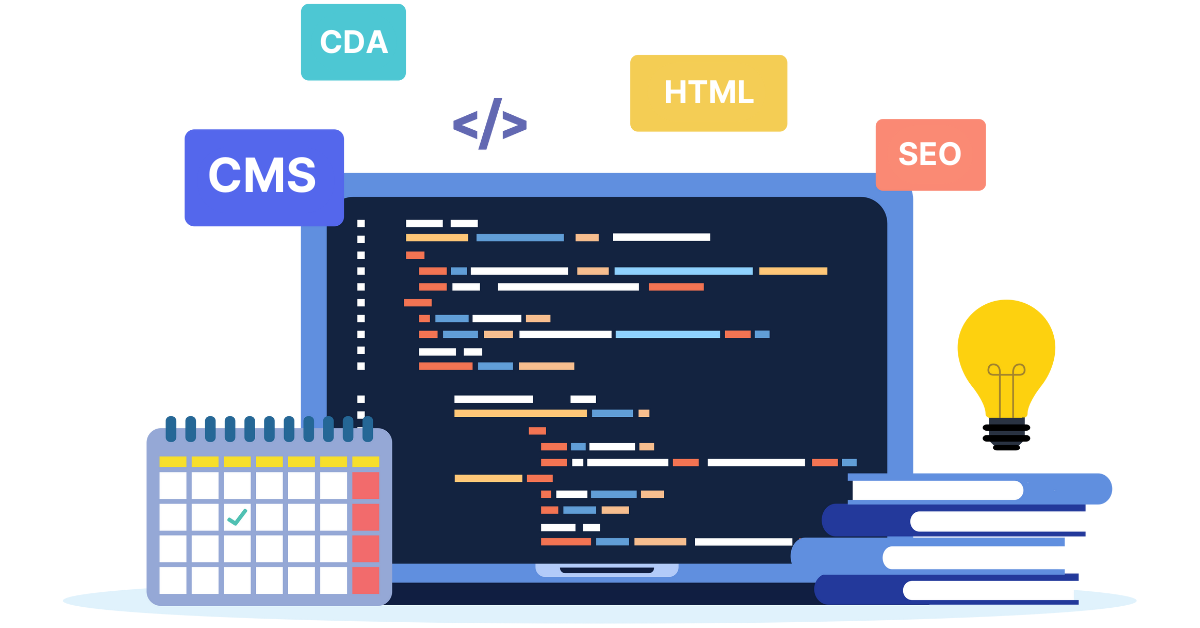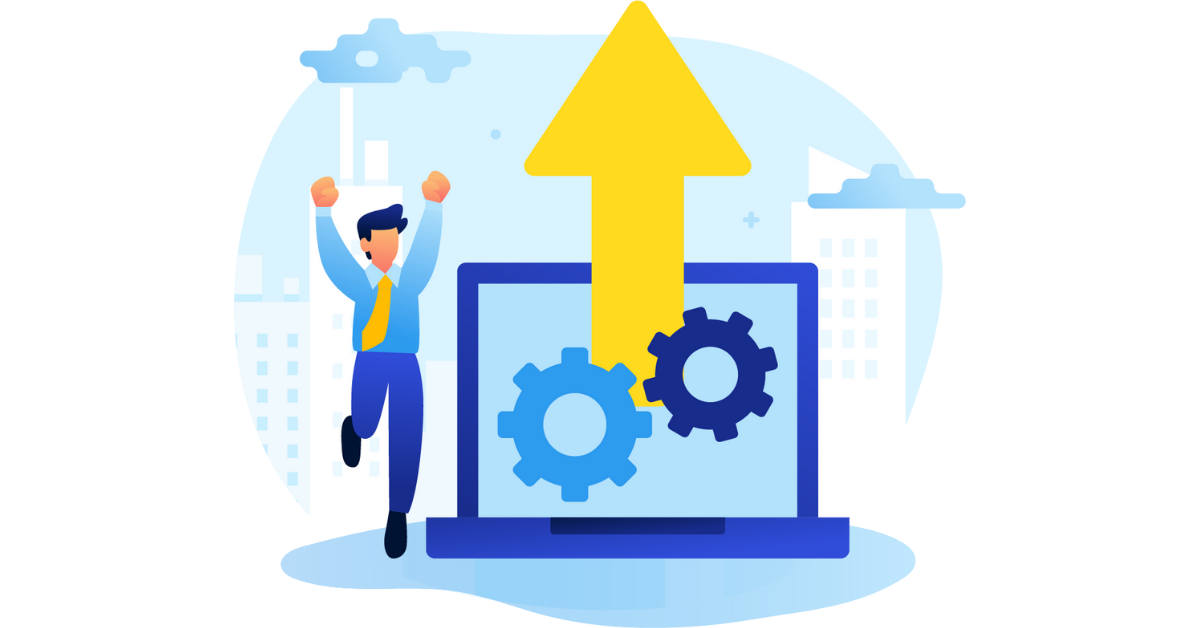What is CMS? It stands for Content Management System—a tool that simplifies your online content creation, editing, and publishing. If you’re diving into building or managing web content, a CMS will save you from the intricacies of coding. This guide is about the what, why, and how of CMS, helpful for beginners and experts as you scale your digital platforms.
Key takeaways
- A Content Management System (CMS) is a versatile software tool that enables users to easily create, manage, and publish digital content without needing extensive technical knowledge.
- CMS technology facilitates collaboration among users through features such as concurrent content access and editing, streamlining workflows, and enhancing productivity across various digital channels.
- CMS platforms come equipped with features for customization, user interaction, media management, and strong security measures to protect content and data.
Understanding content management systems (CMS)

A web content management system (CMS) is a powerful CMS software tool designed to simplify the creation, management, and publication of digital content. It’s like a backstage pass to your website, allowing you to pull the strings behind the scenes. The CMS stores your content in a database and displays it on your website using a predefined set of templates. It’s a godsend for those who want to manage content effectively without the complexities of coding.
The beauty of a CMS lies in its versatility. It doesn’t just handle text, but a whole array of content types, including images, videos, and documents. And thanks to the cloud technology, your CMS can be hosted on a web server, making it accessible from anywhere, at any time.
So, there’s a CMS out there in the content management system market that fits your needs like a glove, no matter if you’re a small business owner wishing to manage your website internally, or a multi-national enterprise needing an extensive content management solution. In fact, most content management systems are designed to cater to a wide range of requirements.
The role of CMS in web content creation
CMS is not merely a tool; it’s the heart of web content creation. It enables users to generate, modify, and oversee content for websites and other digital platforms without needing to master HTML or other programming languages. Imagine being able to manage and update metadata for individual pages or blog posts, all without touching a single line of code. That’s the power of a CMS. It’s a game-changer for businesses, ensuring a uniform user experience across platforms.
There’s a CMS for every purpose. For example, Ghost CMS is designed specifically for blogging. It comes with an intuitive editor and built-in SEO tools, making it a bonus for those seeking a straightforward website. Then there’s Sitecore, tailored for enterprise-level content management, providing personalized digital experiences through its advanced editor and personalization rules. It’s perfect for managing intricate content strategies and offers great analytics capabilities.
For both, a small-time blogger and a large-scale enterprise, there’s a CMS that’s got you covered.
Content management system’s structure

Having introduced you to CMS, we will now explore its structure. The two core components of a CMS are the Content Management Application (CMA) and the Content Delivery Application (CDA). These work together to manage and deliver content effectively. The CMA is where you create and edit your content, while the CDA takes care of publishing and storing that content.
Think of it as a well-oiled machine, with the CMA and CDA working in harmony to keep your digital content flowing smoothly.
Content management application (CMA)
The CMA is your digital canvas, where you create and manage all your content. It’s like the cockpit of your CMS, equipped with:
- An intuitive dashboard
- Responsive themes
- Robust content editing and publishing tools
- Version control
- Security features
CMA makes it a breeze to manage content for various types of pages, such as a blog post, product page, or landing page.
In a headless CMS, the CMA takes on an even more pivotal role. It allows your team to:
- Input and manage content before its publication on the website
- Create, edit, and manage your content all in one place before it goes live
- Keep your digital content fresh and updated seamlessly and efficiently.
Content delivery application (CDA)
The CDA is the unsung hero of your CMS. It’s responsible for compiling the content entered into the CMA, presenting the code to frontend visitors, and storing the content. It’s like the backstage crew in a theater production, working tirelessly behind the scenes to ensure that your content is delivered flawlessly to your audience.
The CDA transforms the content input into templates and converts it into a web-compatible format, enabling visitors to interact with it. It’s the principal cog in the CMS machine, receiving backend content, processing it based on templates, and preparing it for delivery in a format that your website visitors can interact with.
The significance of CMS in modern web development

CMS dominates the field of modern web development. It helps businesses and individuals to:
- Establish and manage websites without requiring extensive technical expertise
- Set up your website with just a few clicks
- Enhance team productivity
- Improve your online visibility
What makes CMS stand out is its scalability and adaptability. If you’re a small business looking for an intuitive user interface or a larger corporation requiring advanced features like Single Sign-On (SSO), scalability, and cloud-based services, there’s a CMS out there for your needs. It’s about finding the right fit for your specific requirements and making it work for you.
Key advantages of using a CMS platform
Using a CMS platform brings numerous advantages. User-friendliness is one of the key advantages, with intuitive interfaces and easy-to-use tools for creating, editing, and publishing content. Even if you’re not a tech whiz, a CMS platform makes it easy for you to manage your web content.
Collaboration is another major advantage of a CMS. With a variety of customization options, you can personalize your CMS experience to suit your needs and preferences, improving your overall user experience. Some key benefits of a CMS include:
- Concurrent access and editing of content by multiple users
- Streamlined workflows
- Improved efficiency
- Customization options for a personalized experience
These are just a few of the key advantages of using a CMS platform, and they all contribute to enhancing overall efficiency and productivity.
If you’re using or planning to use Magento, read our CMS Magento series:
Popular CMS platforms
Exploring the wide range of CMS options can be overwhelming. In this section, we’ll take a closer look at three popular CMS platforms: Sanity.io, Contentful, and Drupal, each offering unique features and benefits to cater to different user needs.
Sanity.io

Sanity.io is a modern CMS that transforms content into a competitive advantage. It offers seamless customization, collaboration, and scalability for digital experiences. With a strong emphasis on structured content, Sanity.io enables endless reuse of content across various channels, treating content as data.
Sanity.io distinguishes itself from other CMS platforms by providing a React-based editor, the easily configurable and customizable Sanity Studio. However, it’s worth noting that the platform might require more maintenance compared to others, and the development process can be more time-consuming.
Contentful

Contentful is a headless CMS that enhances team collaboration, stimulates innovation, and delivers impactful experiences on a large scale. It stands out for its API-first approach and seamless integration with diverse data sources and functionalities.
While Contentful is designed to be user-friendly for both business users and developers, some interfaces may not be as friendly as desired for non-technical users. However, its flexibility and adaptability make it a powerful tool for content management across various channels.
Drupal

Drupal is a highly adaptable CMS preferred by major corporations and government entities, including NASA. Its comprehensive library of modules and themes makes it capable of developing intricate websites that can manage substantial amounts of data and heavy traffic.
Drupal is ideal for corporations and government agencies that require sophisticated and robust websites. However, the expenditure associated with using Drupal can vary, because of the complexity and specific requirements of the project.
CMS and SEO: A match made in digital marketing heaven
CMS and SEO complement each other perfectly. Most CMS platforms come equipped with pre-installed SEO tools and functionalities, making it easier for users to enhance their content for search engines and improve their online visibility. Some of the SEO features offered by CMS platforms include:
- Adding web page titles
- Adding meta descriptions
- Adding alt tags
- Ensuring uniform implementation of SEO best practices across web content
With a CMS, you can take care of all these SEO tasks in one place, saving you time and effort.
The benefits of a CMS with automation for basic on-page optimization tasks cannot be overstated. It streamlines the SEO process and increases your website’s visibility on search engines like Google. Remember, search engines consider factors like:
- Optimized titles
- Content quality and depth
- Keyword density
- Overall user experience
When ranking web pages, search engine optimization plays an important role. These factors can be improved through the use of a CMS’s SEO features.
Content management beyond websites
The application of CMS is not limited to websites. It plays a critical role in managing content across a diverse array of digital channels, including mobile apps, digital signage, and social media. This means that a CMS can help streamline the process.
CMS platforms are especially efficient for managing content in mobile applications as they facilitate the distribution of content and services to mobile devices. CMS streamlines the handling of content, making it easy to schedule and upload videos, images, and documents. Regardless of the digital channel you’re using, a CMS can help you manage your content.
Streamlining collaboration with CMS
A successful digital project relies heavily on collaboration, and CMS simplifies this aspect. CMS platforms facilitate collaboration among team members, streamlining workflows and improving productivity. Some benefits of using a CMS for collaboration include:
- Enabling multiple users to access and publish content
- Offering workflow management, content storage, and scheduling capabilities
- Keeping your team organized and on track
The ability to collaborate effectively is especially crucial in today’s remote working environment. With a CMS, your team can:
- Work together in real-time, regardless of their physical location
- Coordinate their efforts
- Keep track of changes
- Ensure that everyone is on the same page
Having coding knowledge makes it easier for your team to collaborate effectively.
Customizing your CMS experience
CMS enables you to customize your experience to cater to the distinctive needs of your business. From using a range of templates, themes, and plugins, to customizing HTML within content management systems, a CMS lets you personalize your digital experience.
Templates and themes play a critical role in customizing a CMS experience. They allow you to modify the visual design, layout, and operational aspects of your website to align with your brand’s identity and user needs. Moreover, CMS customization allows for the provision of personalized experiences based on user preferences, behavior, and demographics, utilizing features such as content personalization and targeted marketing campaigns.
Security measures in CMS
With the rise of cyber threats, the importance of security cannot be exaggerated. CMS platforms come with strong security measures to protect your content and user data. User authentication is a key aspect of CMS security, validating the identity of users and determining their access privileges. Access control further enhances security by regulating who can access or use resources, enabling more efficient management of access to documents, files, and data within the CMS.
Regular updates are also essential for the security of a CMS. They address vulnerabilities by reducing bugs, eliminating security risks, and correcting any technical errors that could be exploited. Furthermore, CMS platforms like WordPress, Drupal, and Joomla come with their own set of essential security measures to ensure that your content and data remain safe and secure.
Managing media with CMS
CMS platforms also excel in the area of media management. It enables smooth integration with your digital content like images, videos, or audio files. It’s like having a digital media library at your fingertips, with tools to tag, label, or add metadata to your media files for easy searching, filtering, and retrieval.
Even when it comes to handling large media files, a CMS has got you covered. It optimizes the formats and sizes of the files for your website and offers settings to adjust the maximum file size limit for importing and storing media files. CMS makes it easy to manage your media files seamlessly, even if you’re uploading high-resolution images or HD videos.
Enhancing user interaction through CMS design
CMS is more than just a content management tool, it’s about crafting digital experiences. Responsive design in a CMS enhances user interaction by ensuring optimal viewing and interaction across devices. CMS is equipped with features that improve user interaction, like an intuitive dashboard, responsive themes, and powerful content editing and publishing tools.
Several CMS platforms, such as Sanity, and Contentful, are known for providing excellent tools for user personalization. A CMS also contributes to website navigability, improving user experience by offering functionalities like menu management, breadcrumb navigation, and search capability.
It’s all about creating a user-friendly environment that keeps your audience engaged and coming back for more.
Summary
CMS is a powerful tool that can simplify the process of creating, managing, and publishing digital content. There’s a CMS out there that’s just right for you, for managing your website, mobile app, or digital signage. With features like user-friendly interfaces, collaboration tools, customizable templates and themes, and strong security measures, a CMS is an essential tool. So, take the leap and use the possibilities of a CMS to take your digital content to the next level.
Frequently Asked Questions
What does CMS mean?
CMS stands for content management system, which is computer software used to manage content and website structure. It utilizes a database to handle all content.
How does a CMS improve collaboration?
A CMS improves collaboration by allowing multiple users to access and edit content simultaneously, providing version control, and allowing communication through comments and notifications. It is an effective tool for improving teamwork and productivity in various projects.
What are some popular CMS platforms?
Popular CMS platforms include Sanity.io, Contentful, and Drupal, which are known for their user-friendly interfaces and great features.
Ready to explore the possibilities of content management systems? Reach out to the scandiweb team, and let’s find the ideal solution and customize it to suit your needs.



Share on: